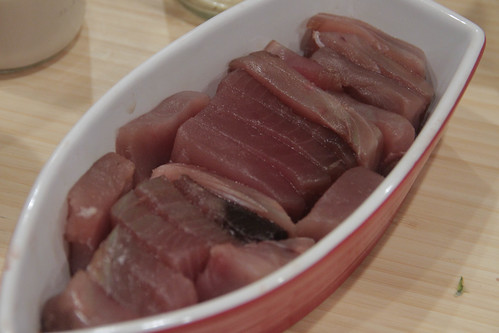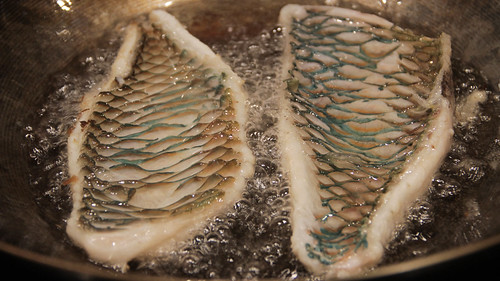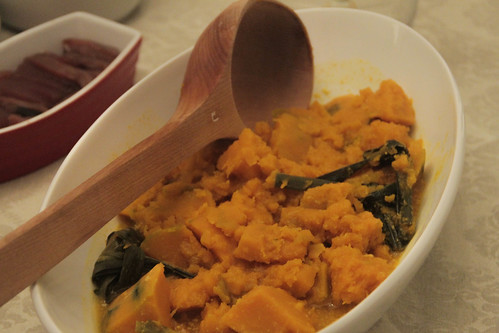Meal 89: Kiribati
Move over, Equatorial Guinea: Kiribati, a constellation of a few dozen atolls in the heart of the Pacific, now holds the title of Country the Least People Have Heard Of, judging from an unofficial tabulation of "huh?"s and "where's that?"s as we told friends and family of this meal. Even if you've heard of it, you geography nerd you, you're probably pronouncing it wrong. Say it "KEE-ree-boss," because it's really a Polynsianism for Gilberts, the British colonial term for the territory they arbitrarily created. That's why it's not called by any native name: as a collection of disparate chains of tiny clumps of land, there was no pre-colonial precedent for what to call it.
Kiribati is right up there in the hardest countries for figuring out the menu. My usual tricks didn't work: No Wikipedia article. No awkward but workable site from an embassy or the Ministry of Culture. No lovingly compiled blog by an expat living there, or a homesick student abroad. No chatter on food discussion boards. Even when I granted myself a temporary reprieve from the prohibition on looking at other cooking-around-the-worlders' sites, much of what I saw didn't ring true (though I ended up borrowing some). When I couldn't find even a Peace Corps cookbook, a trick that rescued me for some smaller West African countries, I took my search to the next level and reached out to a Peace Corps volunteer whose name I found in a newsletter of returned volunteers. Thankfully, Laura Montez quickly replied, and we had a great chat on the phone.

She explained the challenge: there's no cuisine as such, no recipes handed down from grandmothers around the hearth. On the further-flung islands where life is at its most traditional, food is, quite literally, catch as catch can: whatever you manage to pull from the sea; coconuts, breadfruits, and a few sweet fruits from trees; and a limited assortment of roots and squashes. Whatever greens exist are for the pigs and chickens that run around for a special-occasion meal. With that limited assortment, and the notable lack of herbs or other embellishments, it now makes a lot of sense why I didn't find much in the way of recipes. (Note that on the most populated island where the capital is, life is totally the opposite: it's so crowded that there's no land for farming, not even coconuts, so everything has to be shipped in: some from other islands in the country but mostly from Australia/New Zealand. Accordingly, the cuisine is quite different, with canned corned beef, curry powder, and other smatterings of global cuisine.)
So thank you, Laura, for the advice! And to Jaymee, her brother, and Deena for coming. It was a small crowd but we scarfed it all down! (Alas, we were having such a good time we didn't end up getting a group photo. Imagine happy people with their faces stuffed. Done!)
Papaya cocktail

In the spirit of throwing together what you've got, I juiced a papaya, which Deena mixed with some palm juice, lime juice, and rum, and voilà! A suitably tropical-esque drink to get us in the mood.
Te ika | Raw tuna

Laura told me that yellowfin tuna is the most common, but the closest I could find was albacore. I defrosted a few frozen steaks from Trader Joe's — if that sounds weird or unsafe for sashimi, keep in mind it's frozen on the ship very shortly after being pulled out of the water, and much of what you eat in a sushi restaurant was previously frozen anyway. (I also grilled some for those less inclined to raw fish.)
Not knowing how an I-Kiribati would prepare it, I cut the fish into random bite-sized morsels, with little bowls of coconut milk I painstakingly extracted by hand from fruit I cracked, pried out, and shredded. I've done this a few times, and frankly I can't taste much of a difference. From now on, I'll stick to canned, or at least buying it frozen pre-shredded.
Te inai | Fried parrotfish

Fiji Market didn't have most of what I was looking for — dried pandanus fruit, for instance, which I'd read about as being used as a starch — but they came through with a few fun things. A load of this fantastically exotic fish had "just come in last week" according to the friendly owner. A quick search on my phone revealed a parrotfish on a Kiribati stamp, which was good enough evidence for me that they've got it there. I let it thaw overnight in the fridge, removed the scales, and did a halfway decent job at filleting it. Right before we ate, I slipped it into the oil I'd already had going for the breadfruit.
Te mai | Fried breadfruit

We first tasted this peculiar food with the Jamaica meal. Popular as it is in the Caribbean, the tree is actually is native to Polynesia, and appreciated everywhere it grows for providing abundant, filling fruit. It's not sweet, though; like a green plantain, it's mostly starches and needs to be cooked. The tastiest preparation is to boil and then fry it, and that's just what we did, with a generous dusting of salt. Unlike in Brooklyn, I could only find frozen breadfruit at Fiji Market, but my palate, unaccustomed as it is to the food, couldn't tell the difference after cooking. Its artichokey aspect was less pronounced after frying than with grilling, but of course the texture was a whole lot more pleasing.
Te bwaukin | Pumpkin simmered in coconut milk with pandanus leaf | Recipe

Coconut milk isn't just for dipping, it's also a great simmering medium. Coconut milk and pumpkin are both foods that can go either sweet or savory, and in this case tossing on some sugar brings out nice flavor in both. On the islands it'd probably been a palm sap that seems like the Polynesian version of maple syrup; as an attempt of replicating the flavor, I threw in a bit of that palm juice along with regular sugar. (If I'd had my druthers I'd have bought palm sugar, which is easily found at Asian markets.) It's worth noting that coconut and palm are different flavors: while they both definitely have that toasty-nutty undertone in common, coconut is richer and brighter, and palm is muskier.
A new-to-me ingredient showed up in this preparation: pandanus leaf. It's used like bay leaf: added in a simmering dish for the flavor it lends. I later learned that I've definitely tasted it – in the water at Pok Pok, Portland's famous Thai restaurant. I'd always thought the flavoring came from rice, and I wasn't far off: according to Wikipedia, Basmati rice and pandanus share the exact same aromatic compound. So, if you want to impart a Basmati-esque flavor to your next simmered dish, pick up some pandanus from your Asian grocer's freezer.
All this said, a very tasty dish. We gobbled it all down.
Te bua toro | Sweet potato and coconut milk loaf | Recipe (in comments)
Once again to a fellow cooking-round-the-worlder for the recipe — though in this case the insight comes from the comments. (Corrections always welcome on blogs like these!) It's a coconut-milk based casserole wrapped in leaves: we saw this sort of preparation with Fiji, and I suspect we'll see it a fair bit more with more Pacific island nations. I ended up using some sweet potatoes, the drier white variety. The result was again pretty sweet, thanks to sugar, and not terribly impressive. I'll stick to the simmered pumpkin, thank you.